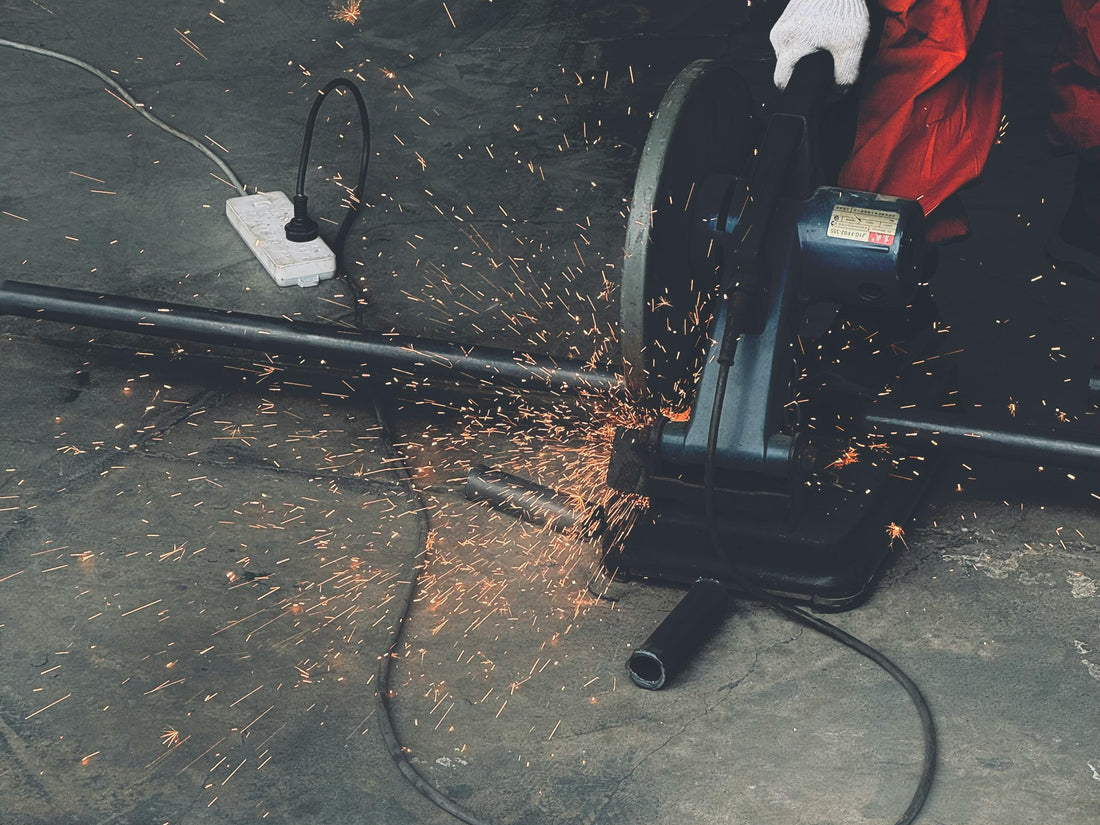How to choose the right grinding wheel
With so many cut-off wheels available, choosing the right cut-off wheel for your corner grinder and cutting the material you are using can be a challenge. In this article, we will go over the cut-off wheel features that should be considered when selecting cut-off wheels for your application.
What is a cutting wheel?

Cutting wheels, also known as cut-off wheels, typically cut the material closely and precisely at a 90° angle. The cutting wheel cuts the material, as opposed to the grinding wheel which grinds the large material on the workpiece from a shallow angle. The cutting wheel is different from the grinding wheel in function and structure. The big advantage of using cutting wheels and angle grinders is that they are easily set up to cut when needed.
What abrasives can be used to cut grinding wheels?
Grinding wheels have four main types of abrasive particles, namely:
Alumina ceramicCeramic alumina is another major development in abrasives. These are high purity particles manufactured using a gel sintering process. The result is an abrasive capable of breaking at a controllable rate at submicron scale, constantly producing thousands of new cutting points. This abrasive is extremely hard. It is mainly used for precision polishing in high demand applications of steel and alloys that are more difficult to grind. Abrasives are often mixed with other abrasives in different percentages to optimize their properties in different applications and materials. |
 |
Silicon carbideSilicon carbide is an abrasive used for grinding gray iron, hard iron, brass, soft bronze and aluminum, as well as stones, rubber and other non-ferrous metal materials. |
 |
Zirconia AluminaZirconia-alumina is another class of abrasives, each of which is made from different proportions of alumina and zirconia. This combination produces a tough, durable abrasive that works well in coarse grinding applications such as cutting operations, suitable for all types of steel and steel alloys. Like alumina, there are several different types of Zirconia-alumina available. |
 |
AluminaAlumina is the most commonly used abrasive in grinding wheels. It is typically an abrasive used for grinding carbon steel, alloy steel, high-speed steel, annealed malleable iron, wrought iron, and bronze and similar metals. There are many different types of alumina abrasives, each of which are specifically manufactured and blended for specific types of grinding work. Each type of abrasive has its own name, usually a combination of letters and numbers. These names vary by manufacturer. |
 |
Once the grit size is known, the next issue is grit size. Each grinding wheel has a number to indicate this characteristic. Grit particle size refers to the size of the individual abrasive particles on the grinding wheel. It corresponds to the number of openings per linear inch in the final screen size used to determine the particle size. In other words, the higher the number, the smaller the opening in the screen through which the particles pass. Lower numbers (such as 10, 16, or 24) indicate coarse grit wheels. The coarser the particle, the larger the size of the material removed. Coarse particles are used to quickly remove unimportant size. Higher numbers (such as 70, 100, and 180) are fine grinding wheels. They are suitable for giving fine surface treatment, contact on small areas, and use with hard, brittle materials.
What material are you going to grind?
The type of material affects the selection, particle size and grade of abrasives.
Aluminum oxide type abrasives are best suited for grinding high strength materials such as steel and ferritic cast iron. On harder steel and applications with large contact arcs, more brittle alumina types are preferred.
Low tensile strength and non-metallic materials are most effective for grinding or cutting with silicon carbide abrasives. The hardness of the material determines the amount of penetration the material can achieve.
Therefore, finer grit grinding wheels are needed to grind hard materials, while soft materials are best ground by medium and coarse grit grinding wheels. To achieve the most efficient operation, the level should be adjusted to suit the hardness of the material.
Generally, the harder the material, the softer the wheel grade required.
When is which cutting wheel used?
The .045 cutting wheel is specifically designed for cutting metals and its thickness (known as "chip") is much thinner than the grinding wheel (1/4 inch) and pipe wheel (1/8 inch). This is because grinding and pipe wheels are primarily designed for grinding metals rather than cutting. The increased thickness of the grinding wheel makes cutting operations more difficult as users need to remove more material when cutting, leading to frustration and longer, inefficient cutting times.
- 045 Wheels :045 wheels are the best choice for efficient cutting. Please note that never use a .045 grinding wheel to remove metal burrs after cutting or grinding, as this incorrect use may cause grinding wheel failure and serious injury.
- 090 Wheels:.090 wheels are specially designed for cutting and grooving metal. Cutting is a shearing process in which metal debris is removed from the outer edge of the metal workpiece prior to welding.
- 095 Final Combination Wheel: The most universal cutting wheel is the Final Combination Wheel, with a thickness of 0095. The unique thickness of this grinding wheel allows the operator to cut, slot, deburr and light grind without changing the grinding wheel.
So that the abrasives on the wheel

In order for grinding wheels to cut effectively, the grinding wheel must contain a suitable adhesive. Adhesives are materials that bind abrasive particles together for effective cutting. As the abrasive particles wear away and are ejected, the adhesive must also wear away, thus exposing new, sharp particles.
There are three main types of adhesives used on traditional grinding wheels. Each type can give different characteristics to the grinding action of the grinding wheel. The type of bond chosen depends on factors such as the operating speed of the grinding wheel, the type of grinding operation, the precision required, and the material to be ground.
Most grinding wheels are made from glass adhesives, which are composed of a carefully selected clay mixture. At high temperatures produced in the furnace where the grinding wheels are made, the clay and abrasive particles fuse into a molten glass state. During cooling, the glass forms a span that connects each grain to an adjacent grain and provides it with support when grinding.
Grinding wheels made of glass adhesives are very hard, solid and porous. They remove raw materials at high speed and grind them to precise requirements. They are not affected by water, acid, oil or temperature changes.
Vitreous adhesive is very hard, but at the same time it is as fragile as glass. These keys were damaged by the grinding pressure.
Some bonds are composed of organic material. These adhesives soften under the heat of grinding. The most common type of organic bond is resin bond, which is made of synthetic resin. For applications requiring fast pulp removal and applications requiring better surface treatment, resin bonded wheels are a good choice. They are designed to run at higher speeds, typically for wheels in fabrication shops, foundries, billet shops, as well as for sawing and glue application.
Another organic adhesive is rubber. Wheels made from rubber adhesives have a smooth grinding effect. Rubber adhesives are generally used on wheels that require high-quality surface treatment, such as ball bearings and roller bearing races. They are also frequently used on cutting wheels and burrs and burns must be kept to a minimum.
The bond strength is specified by the grade of the grinding wheel. This bond is considered hard grade if the span between each grinding grain is very large and is able to hold the grinding grain well to resist the grinding force that tends to loosen it. If only a small force is needed to release the particles, the wheel is considered to have a soft grade. The relative amount of bond in the wheel determines its grade or hardness.
Hard wheels are used for longer wheel life, work on high-powered machines, and work with small or narrow contact areas. Soft wheels are used for fast discharges, large-scale contact work, and hard materials such as tool steel and carbide.
So which cutting wheel should I use?
In the end, the correct choice of cutting wheel used with the corner grinder depends on what you want to cut and your preferences. Use the following combination abrasive chart to help you determine the appropriate grinding wheel.


